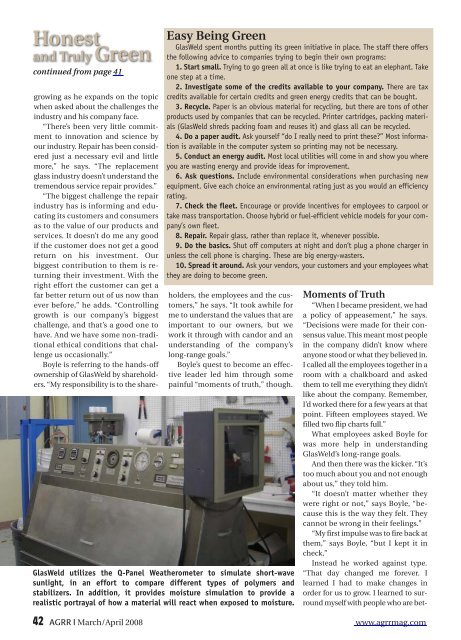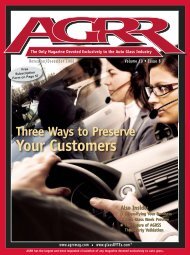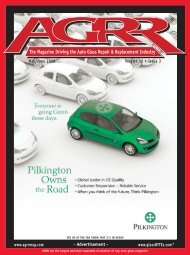AGRR - March/April 2008 - AGRR Magazine
AGRR - March/April 2008 - AGRR Magazine
AGRR - March/April 2008 - AGRR Magazine
Create successful ePaper yourself
Turn your PDF publications into a flip-book with our unique Google optimized e-Paper software.
Honestand Truly Greencontinued from page 41growing as he expands on the topicwhen asked about the challenges theindustry and his company face.“There’s been very little commitmentto innovation and science byour industry. Repair has been consideredjust a necessary evil and littlemore,” he says. “The replacementglass industry doesn’t understand thetremendous service repair provides.”“The biggest challenge the repairindustry has is informing and educatingits customers and consumersas to the value of our products andservices. It doesn’t do me any goodif the customer does not get a goodreturn on his investment. Ourbiggest contribution to them is returningtheir investment. With theright effort the customer can get afar better return out of us now thanever before,” he adds. “Controllinggrowth is our company’s biggestchallenge, and that’s a good one tohave. And we have some non-traditionalethical conditions that challengeus occasionally.”Boyle is referring to the hands-offownership of GlasWeld by shareholders.“My responsibility is to the shareholders,the employees and the customers,”he says. “It took awhile forme to understand the values that areimportant to our owners, but wework it through with candor and anunderstanding of the company’slong-range goals.”Boyle’s quest to become an effectiveleader led him through somepainful “moments of truth,” though.GlasWeld utilizes the Q-Panel Weatherometer to simulate short-wavesunlight, in an effort to compare different types of polymers andstabilizers. In addition, it provides moisture simulation to provide arealistic portrayal of how a material will react when exposed to moisture.Easy Being GreenGlasWeld spent months putting its green initiative in place. The staff there offersthe following advice to companies trying to begin their own programs:1. Start small. Trying to go green all at once is like trying to eat an elephant. Takeone step at a time.2. Investigate some of the credits available to your company. There are taxcredits available for certain credits and green energy credits that can be bought.3. Recycle. Paper is an obvious material for recycling, but there are tons of otherproducts used by companies that can be recycled. Printer cartridges, packing materials(GlasWeld shreds packing foam and reuses it) and glass all can be recycled.4. Do a paper audit. Ask yourself “do I really need to print these?” Most informationis available in the computer system so printing may not be necessary.5. Conduct an energy audit. Most local utilities will come in and show you whereyou are wasting energy and provide ideas for improvement.6. Ask questions. Include environmental considerations when purchasing newequipment. Give each choice an environmental rating just as you would an efficiencyrating.7. Check the fleet. Encourage or provide incentives for employees to carpool ortake mass transportation. Choose hybrid or fuel-efficient vehicle models for your company’sown fleet.8. Repair. Repair glass, rather than replace it, whenever possible.9. Do the basics. Shut off computers at night and don’t plug a phone charger inunless the cell phone is charging. These are big energy-wasters.10. Spread it around. Ask your vendors, your customers and your employees whatthey are doing to become green.Moments of Truth“When I became president, we hada policy of appeasement,” he says.“Decisions were made for their consensusvalue. This meant most peoplein the company didn’t know whereanyone stood or what they believed in.I called all the employees together in aroom with a chalkboard and askedthem to tell me everything they didn’tlike about the company. Remember,I’d worked there for a few years at thatpoint. Fifteen employees stayed. Wefilled two flip charts full.”What employees asked Boyle forwas more help in understandingGlasWeld’s long-range goals.And then there was the kicker. “It’stoo much about you and not enoughabout us,” they told him.“It doesn’t matter whether theywere right or not,” says Boyle, “becausethis is the way they felt. Theycannot be wrong in their feelings.”“My first impulse was to fire back atthem,” says Boyle, “but I kept it incheck.”Instead he worked against type.“That day changed me forever. Ilearned I had to make changes inorder for us to grow. I learned to surroundmyself with people who are bet-42 <strong>AGRR</strong> <strong>March</strong>/<strong>April</strong> <strong>2008</strong> www.agrrmag.com





